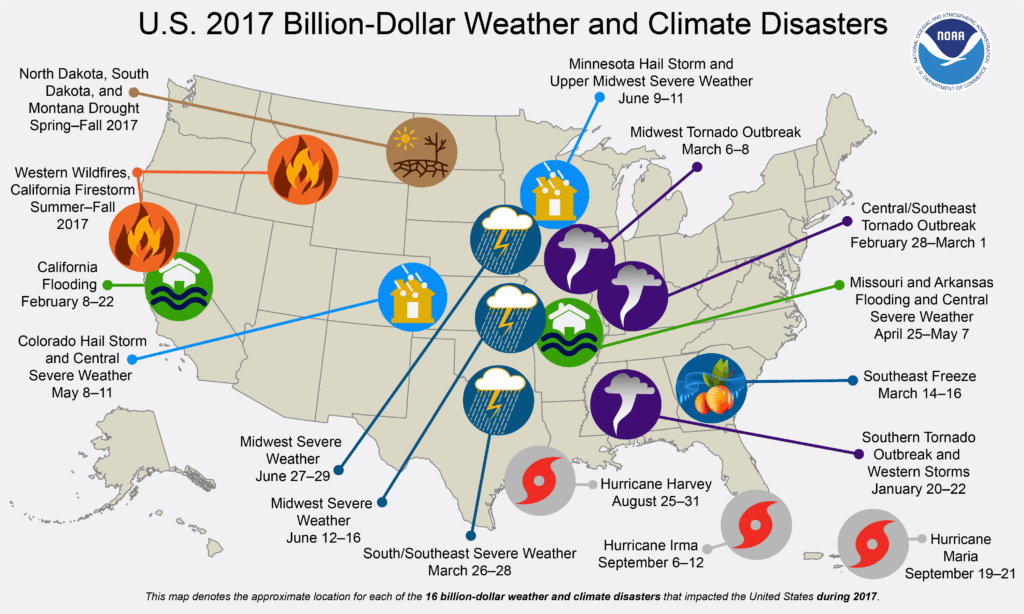2017: The Costliest Year for Disasters in the United States
2017 was the most expensive year on record for disasters in the United States. In total, there were 16 separate events that caused more than $1 billion dollars in damage each, including hurricanes, wildfires, tornadoes and more.
16 Weather and Climate Disasters
Drought
Extreme drought hit North Dakota, South Dakota and Montana in the spring of 2017. The drought caused more than $2.5 billion in damage, hurting production of both field crops and livestock. Furthermore, the severe dry spells made these western and northwestern states more susceptible to wildfires.
Wildfires
Wildfires blazed across many western and northwestern states in 2017. California saw the worst of the flames when a record-breaking firestorm damaged more than 15,000 homes and businesses. Many other states, including Montana, Idaho and Oregon, were also affected. The historic firestorm burned over 9.8 million acres, and caused damage in excess of $18 billion.
Hurricanes
There were three separate billion-dollar tropical cyclone events in 2017 - Hurricane Harvey, Hurricane Irma and Hurricane Maria.
Hurricane Harvey, 2017’s most expensive disaster, caused more than $125 billion in damage when it hit Houston in August. This Category 4 hurricane led to historic flooding, displacing over 30,000 people and destroying over 200,000 homes and businesses. Unfortunately, this was only the beginning of a catastrophic hurricane season for the United States.
Next, in September, Hurricane Irma made landfall in Florida. Another Category 4 hurricane, Irma destroyed over 25% of the buildings in the Florida Keys. The severe wind and storm surge moved up the coast, causing more than $50 billion dollars in damage to Florida and South Carolina.
Shortly after Irma, Hurricane Maria caused widespread devastation in the U.S. Virgin Islands and Puerto Rico. The high winds and extreme rainfall of this Category 4 hurricane led to widespread flooding and mudslides. The hurricane left behind over $90 billion in damaged transportation, agriculture, communication and energy infrastructure. Almost five months later, the islands are still struggling to recover.
Flooding
Heavy rain struck California in early 2017. The subsequent flooding led to a multi-day evacuation and substantial damage to property and infrastructure. The estimated cost of recovery was over $1.5 billion.
Two months later, the Midwest was hit by a period of heavy rainfall. Severe flooding led to widespread damage to homes, businesses, infrastructure and agriculture alike. Damages in the Midwest reached $1.7 billion.
Freeze
In March of 2017, severe freeze heavily damaged crops across the Southeast. Georgia and South Carolina felt the brunt of the cold with peaches, blueberries, strawberries and apples being most impacted fruit crops. Overall, the Southeast freeze cost more than $1 billion.
Severe Storms
Eight severe storm events hit the United States in 2017, totaling $16.5 billion in damages.
Tornados wreaked havoc in the southern states, including California, Alabama, Florida, Georgia, Louisiana, Mississippi, Southern Carolina and Texas. Seventy-nine tornadoes were confirmed during a tornado outbreak in January, with another 70 developing during a second outbreak the next month. A third tornado outbreak occurred in March, this time swirling across the Midwest. Damages from the three severe storm events exceeded $5.1 billion.
Additionally, five hail storms pummeled the U.S. Large hail and high winds impacted states all over the country, from Wyoming to Virginia. The storms proved very expensive, with estimated costs exceeding $11.4 billion.
The Future of Natural Disasters
With 2017 breaking records for the amount of damage caused, many people are worried about what 2018 will bring.
Scientists fear that climate change could make these extreme weather events both more damaging and more common. Torsten Jeworrek, a Munich Re board member thinks that 2017’s disasters are giving us a foretaste of what is to come. He said in an article on WashingtonPost.com, “... even though individual events cannot be directly traced to climate change, our experts expect such extreme weather to occur more often in future.”
Implement a business continuity and disaster recovery plan today to protect your organization from the disasters of tomorrow.

You are well on your way toward protecting your staff and organization.
Take the next step toward protecting your organization by learning more about emergency notification systems and the vital role they play in your emergency preparedness plan.
